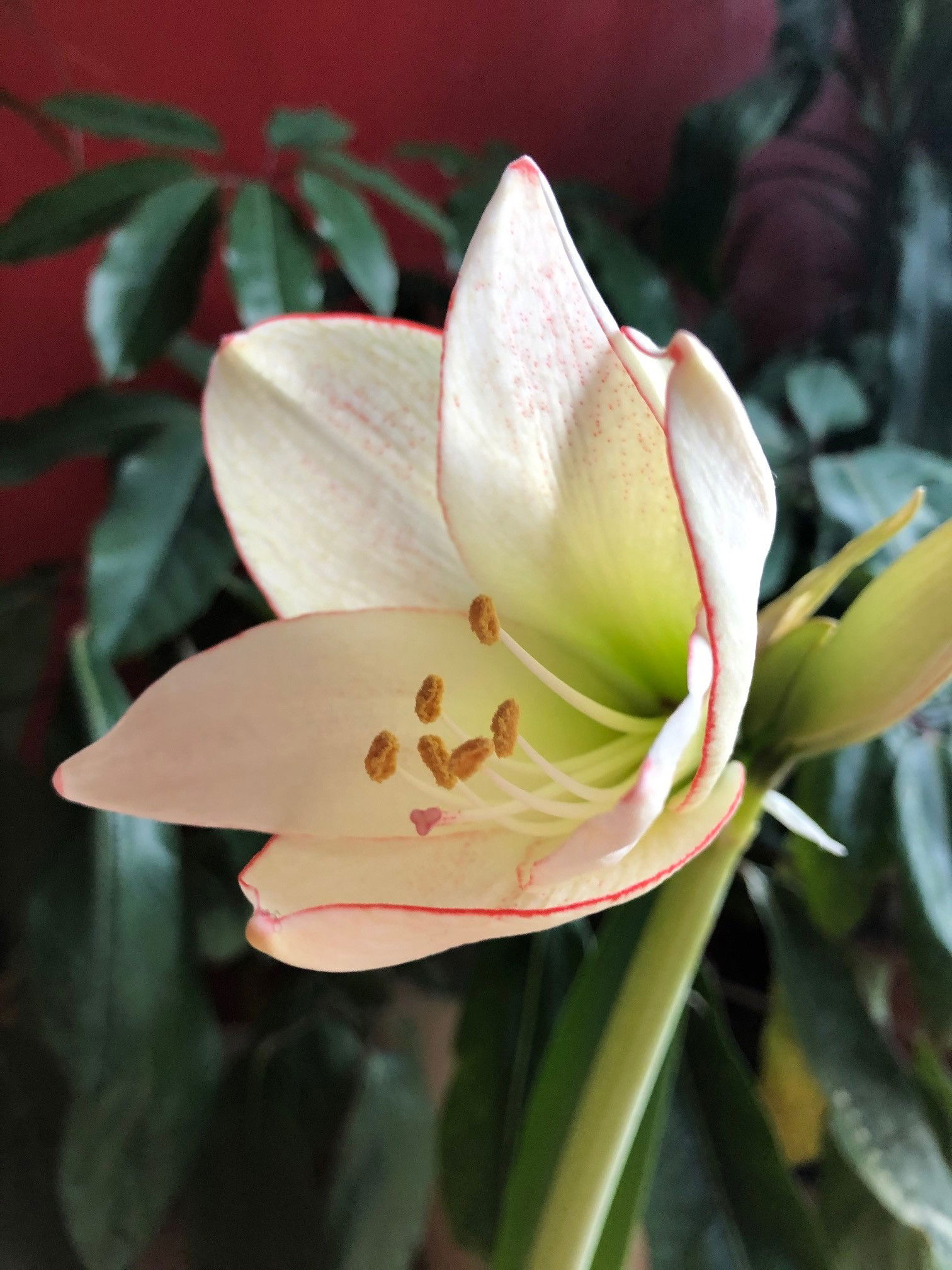
Hippeastrum
Contents
- Top Tips
- Location, Water, Humidity & Fertilisation
- Dormancy Care & Annual Flowers
- Common Issues
- Origins, Temperature, Propagation, Repotting & Toxicity.
Need the answer to a specific plant query? Book a 1-to-1 video call with THE HOUSEPLANT DOCTOR™, the website's friendly author, to overcome and address your niggling problem! Available on iMessage, WhatsApp, Facebook Messenger & more.
Top Tips & Info
- Care Difficulty - Easy
- Keep the plant on the drier-side to life, only rehydrating once the majority of the soil dries out.
- When potting-up in compost, keep the top 30% of the bulb above the soil line for bacterial issues. Scroll down to 'Repotting' towards the bottom of the article for more information.
- Provide bright light to reduce the risk of foliage collapse and bulb rot. We'd recommend situating yours on a windowsill or somewhere that offers overhead lighting to complement its upright growth habit.
- Use a potassium-based feed whilst in bud/bloom, before reverting to a 'Houseplant' fertiliser every five waters for the rest of the year.
- A lack of flowers could be down to too warm or moist conditions during the autumn and winter months. Scroll down to 'Dormancy Care & Annual Flowers' for more information on achieving perennial blooms.
- Choose between keeping the foliage or removing them after the flowering period. You can safely remove its leaves if they begin to 'droop', too; scroll down to 'Pruning' for more information on this.
Location & Light - 🔸🔸
A location with a splash of morning or evening sun is the ideal setting for this species, as too dark scenes will heighten the chance of root or bulb rot. If you're worried about its location being too dark, if a newspaper can be read whilst having your back towards the light source, you're good to go. Although direct sunlight is beneficial for an Amarylis, avoid scorching the leaves with too intense rays as this will quickly lead to a murky green appearance.
In terms of the ideal location around the house, as long as the desired location is above 15ºC (59ºF) and is at least four metres from an operating heat source, it'll be accepted. Do not situate it in a dark location metres away from a light source, as this will only increase the chance of over-watering.
Water - 🔸
Allow the top half of the soil to dry out in between waters during blooms in the winter or early spring. Once the pot feels light when lifted, compared to when you last watered it, this is the best time to rehydrate. Once the blooms have elapsed, reduce the frequency of irrigations further to replicate its dormancy from late winter until the summer. There's no siding-factor when watering your Amaryllis; most people pour water directly into the soil, whereas others use the bottom-up method by submerging the plant in a pool of water for a short spell. As long as the bulb never sits in soggy or standing water unnecessarily, it'll be happy for years to come. It's always better to under-water an Amaryllis than over-do it, as they naturally grow in semi-dry hillsides around Southern America. Under-watering symptoms include curled or crispy leaves, wilted foliage, yellowing leaves and stunted growth. Only allow the majority of the soil to become dry once the plant is in its dormancy period after the festive period. Over-watering symptoms include yellowing or browning leaves, stunted growth, wilting and a rotten bulb. Avoid the soil becoming overly saturated due to the species' susceptibility to root rot and other soilborne diseases. If this has happened to your specimen, increase the intensity light somewhat with fewer irrigations - a fully softened bulb will spell the end of its life. Over-watering is commonly caused by too little light or heat or a lack of drying soil in between irrigations.
Humidity - 🔸
Typical humidity found in the home is more than enough to occupy an Amaryllis, as too high humidity and poor air circulation may result in powdery mildew. Never mist the flowers to increase its humidity as botrytis petal blight will develop.
Fertilisation - 🔸🔸
Fertilisation isn't a critical part of a successful show of blooms. During the budding or flowering period (winter onwards), use a diluted 'Houseplant' labelled feed in with every fifth water to provide higher potassium levels, which will elongate the flowers' lifespan. Once the blooms have begun wilting, reduce the frequency of fertilisation to every six weeks until the leaves fall off or are pruned to make way for the dormancy period (from spring until summer, before beginning to grow again in the autumn). Fertilisation is not needed once the bulb has no leaves.
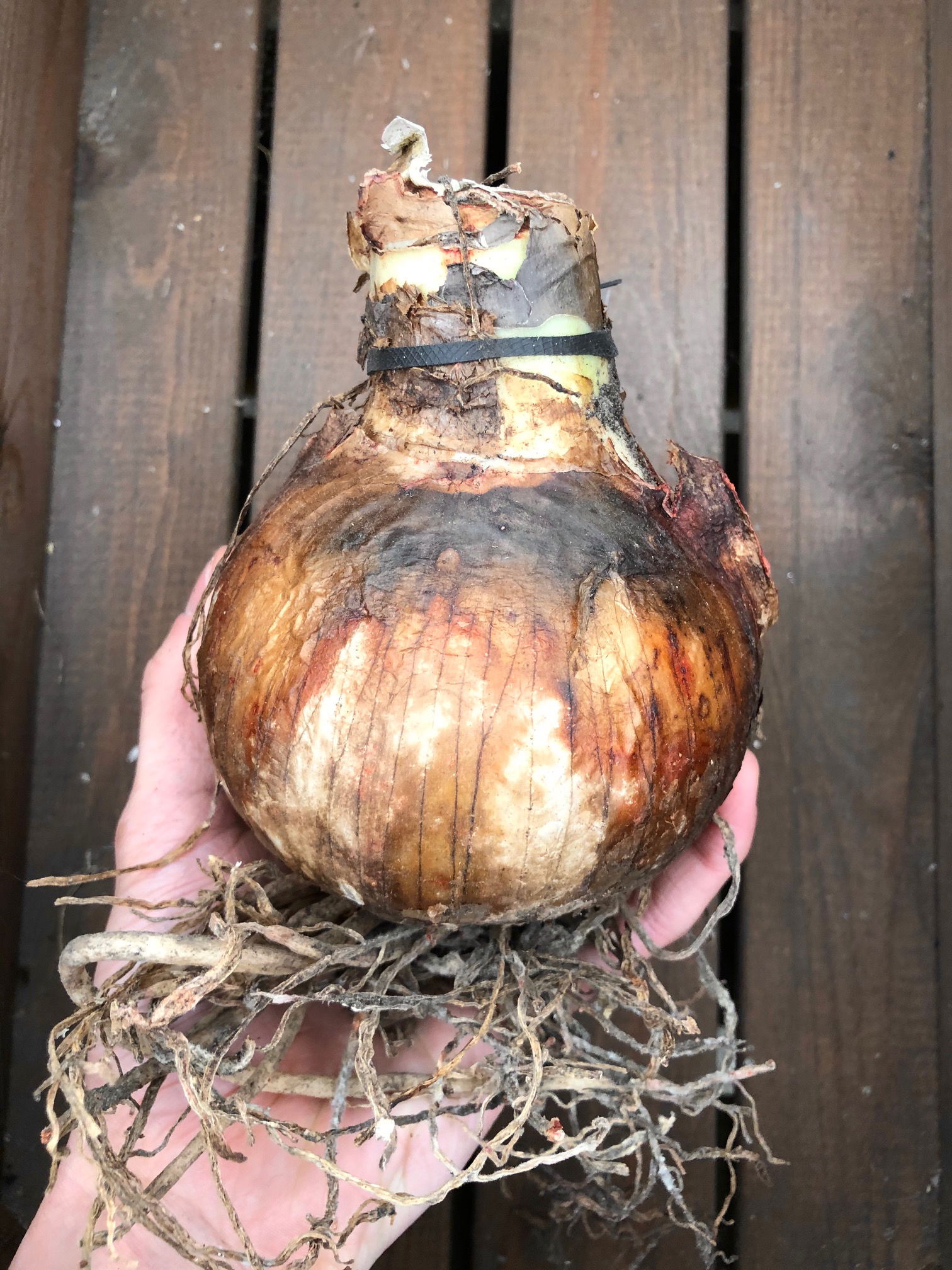 A healthy specimen from the local garden centre for £7.99, which is roughly the price you'll pay for a bulb.
A healthy specimen from the local garden centre for £7.99, which is roughly the price you'll pay for a bulb.
Dormancy Care & Annual Flowers
Amaryllis can keep flowering year after year in the right care - sometimes even twice within twelve months! ukhouseplants have specimens that are now over twenty years old, which have produced their own 'bulbils' (smaller bulbs that develop into an individual plant), producing beautiful blooms each year, without fail. A good dormancy period shortly after the spent flowers will allow the bulb to regain its strength for the following year. There's no need to cut the leaves off, but removing them won't be a detriment either. Here are the key tips for keeping an Amaryllis for years to come, and how to prepare for its dormancy from late winter onwards.
Droughts, Droughts, Droughts!
It's all about under-watering with Amaryllis. If THE HOUSEPLANT DOCTOR™ told you that they could bloom even without roots or soil, it speaks for itself about how little this species can thrive off. Only rehydrate the soil once the majority has fully dried out; never promote soggy soil or water-logging as both will quickly lead to an unhappy plant. The bulb will enter its dormancy shortly after flowering, so this is a perfect time to neglect it for a while. Allow all of the soil to become dry for two weeks in between irrigations, slowly increasing the frequency from late summer onwards to encourage a bloom.
Potbound Roots
An Amaryllis' roots must be pot bound to aid the chance of another bloom, much like the Moth Orchid or Anthurium, for example. The plant must feel restricted in order to send out a flower stalk, thus to reproduce and pass-on the genes. Of course, there are other factors, such as the temperature and daylight hours, that can help this process but starting with its roots is always a good idea. An added bonus of keeping the plant pot bound is that you're far less likely to over-water due to the balance of soil to roots, greatly favouring the latter.
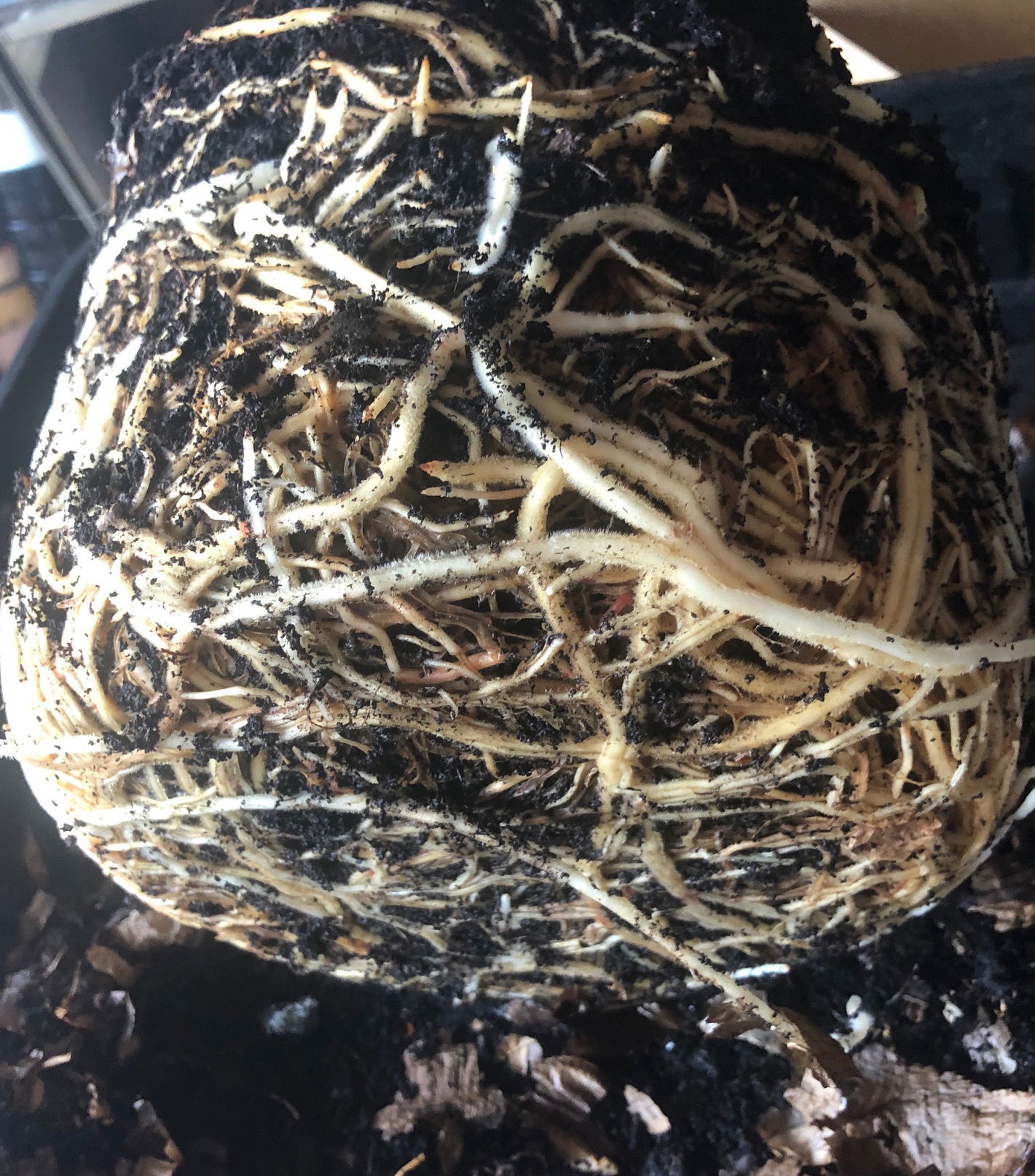 For most plants, potbound roots is a bad idea; however, Amaryllis can flower each year if kept this way.
For most plants, potbound roots is a bad idea; however, Amaryllis can flower each year if kept this way.
Temperature
Although this is not an essential element for showy flowers, reducing the surrounding temperature by a few degrees in the spring will work wonders. Many houseplants won't serve a good dormancy over the winter, purely because of the average household temperature being more or less consistent throughout the year. Situating an Amaryllis in a cooler location shortly after the flowering process will empathise this period, thus focusing its energy on producing blooms later in the year.
Common Issues with Amaryllis
Over-watering is the biggest issue with Amaryllis. Although moist soil is vital for long-lasting flowers, avoid keeping the compost saturated for extended periods to prevent the chance of rot. Allow the top half of the soil to become dry in between irrigations, and always remember to use tepid water to avert shocking the tender root systems. Typical signs of over-watering include yellowed leaves, stunted growth and a softened bulb. During its dormancy (shortly after flowering from late winter), reduce the frequency of waters considerably until late summer.
Too little light could cause wilting or sinking leaves, but without a softened bulb. Its leaves will begin to bend over, still sporting a healthy green appearance. This process may happen soon after the flowering period, but owners should be alarmed - either support or remove the leaf. If you're scared that the location is too dark, as long as a newspaper can be read (when facing away from the light), you're good to go. If this has occurred with your specimen, improve the amount of light fractionally, keeping in mind the increased chance of environmental shock (when two locations offer too different growing conditions) and, of course, sun-scorch.
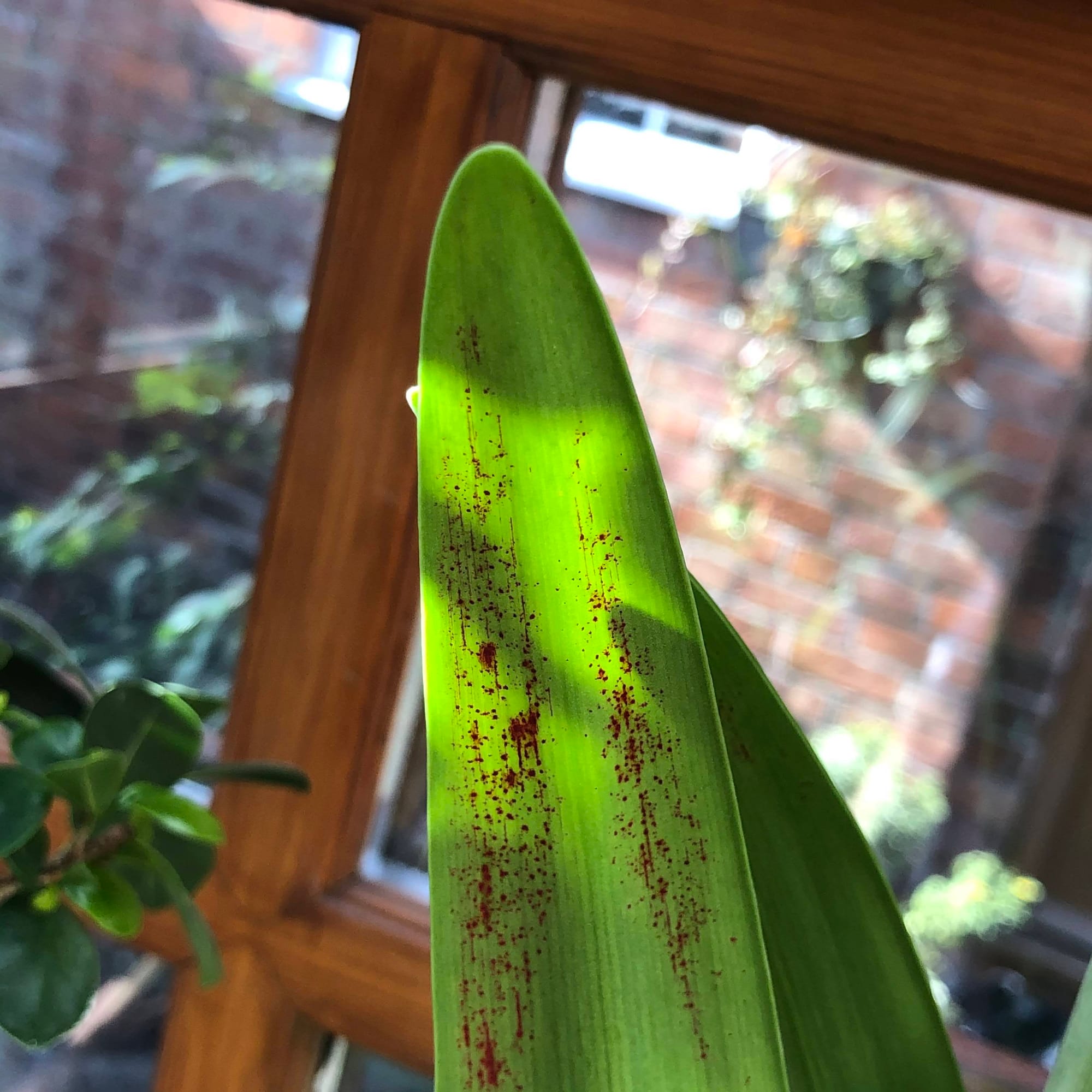 This is a harmless phenomenon which can be over-seen. You can either allow the leaf to stay on the bulb or simply prune it off at its base - it's up to you!
This is a harmless phenomenon which can be over-seen. You can either allow the leaf to stay on the bulb or simply prune it off at its base - it's up to you!
Too much sunlight will lead to sun-scorch, with typical signs including browning or crispy leaves, dry leaf-edges, curled leaves or little growth. Although too low light will cause over-watering issues, too much sunlight will also be a detriment in the likes of dehydration. A location that offers a little to no direct sunlight will bring the optimum growth for the Amaryllis.
A lack of flowers can be an array of different issues, including a poorly spent dormancy, too much water or surrounding heat over the non-flowering months and an over-potted bulb. A period of dormancy from January onwards) will depict whether or not your Amaryllis will bloom. The second factor could be to do with how much water or heat you give the bulb over the course of the year. It would help if you replicated their dormancy by reducing the frequency of waters, which in turn can allow the plant to rest. The final, most crucial element of a successful bloom is how restricted the roots have become; some Amaryllis need to be potbound to bloom, as the plant will think it's nearing the end of its life. Scroll up to the next section of this article to learn about the ideal dormancy period.
If your Amaryllis produces a thick bulb-like growth where the flowers used to be, don't panic. This just means your blooms were pollinated and will shortly produce thin black seeds that can be collected once the seedpod opens and turns crispy-brown. Feel free to prune it off if you're not fussed about seed development.
Origins
The Amaryllis sold commercially throughout the festive period isn't actually an Amaryllis at all - its genuine name is in fact, Hippeastrum. The latter originates from rocky hills in South America and was first described by Carl Linnaeus as the 'Amaryllis Belladonna' (hence the confusion), before being placed in its own genus in the early 19th century. The name comes from the Latin for 'Knight's Star', despite there being no official explanation for its reasonings.
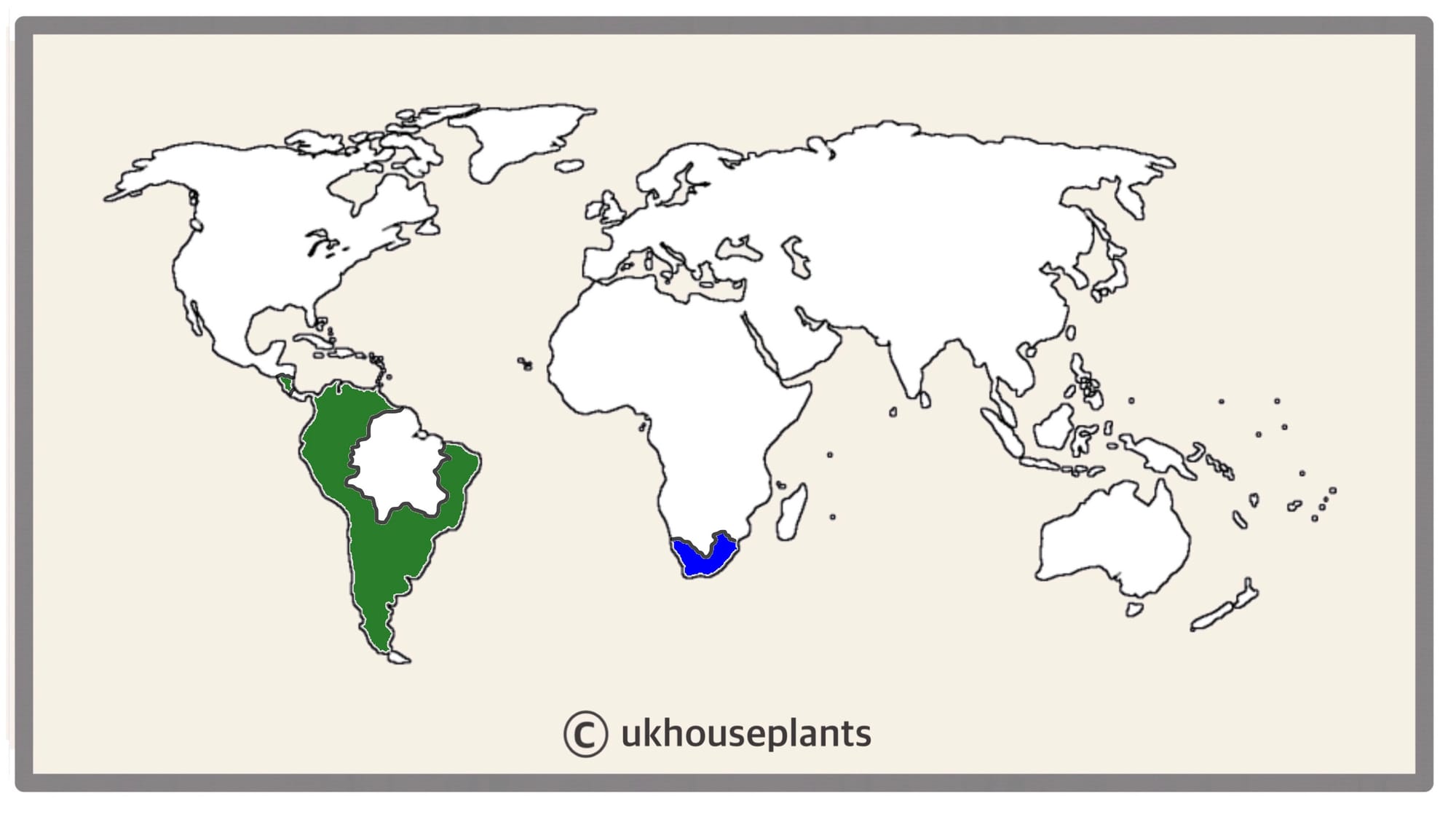 The Distribution of Hippeastrum (labelled 'Amaryllis' that are sold at Christmas) in Green & the true Amaryllis in Blue.
The Distribution of Hippeastrum (labelled 'Amaryllis' that are sold at Christmas) in Green & the true Amaryllis in Blue.
Temperature
6° - 25°C (42° - 78°F).
H1c - The bulb can be placed outdoors in late summer in a sheltered location, whilst the night temperatures are above 8°C (46°F). Situating the potted bulb (with or without foliage) outside a few months before the festive period will greatly improve the chance of potential flowers. Regularly keep an eye out for pests (mealybugs & snails) during its time outside and for the first month after being relocated back in the home.
Spread
Bulb - Up to 30cm in diameter.
Leaf Blades - Up to 80cm in length and 7cm in width.
Maturity can be reached within five years before producing 'bulbils' - lateral bulbous growth that'll develop into its own organ eventually. Both Amaryllis and Hippeastrum can last in excess of thirty years if kept in good care.
Pruning & Maintenance
Remove yellowed or dying leaves and plant debris to encourage better growth and improve the all-round appearance. Pruning must be done with clean scissors or pruners to reduce the chance of bacterial and fungal diseases; remember to make clean incisions as too much damage can shock the plant.
Its leaves can be taken off shortly after the flowering period, or can be left throughout the year - this solely depends on the grower's choice. Once the blooms have elapsed, the flower stalk can be removed with a clean pair of scissors without harming the bulb. There's no need to remove the dead flakes off the bulb, as it acts as a protection to diseases. If the leaves begin to wilt, be sure to cut them off around two inches from the bulb's top to promote better future growth.
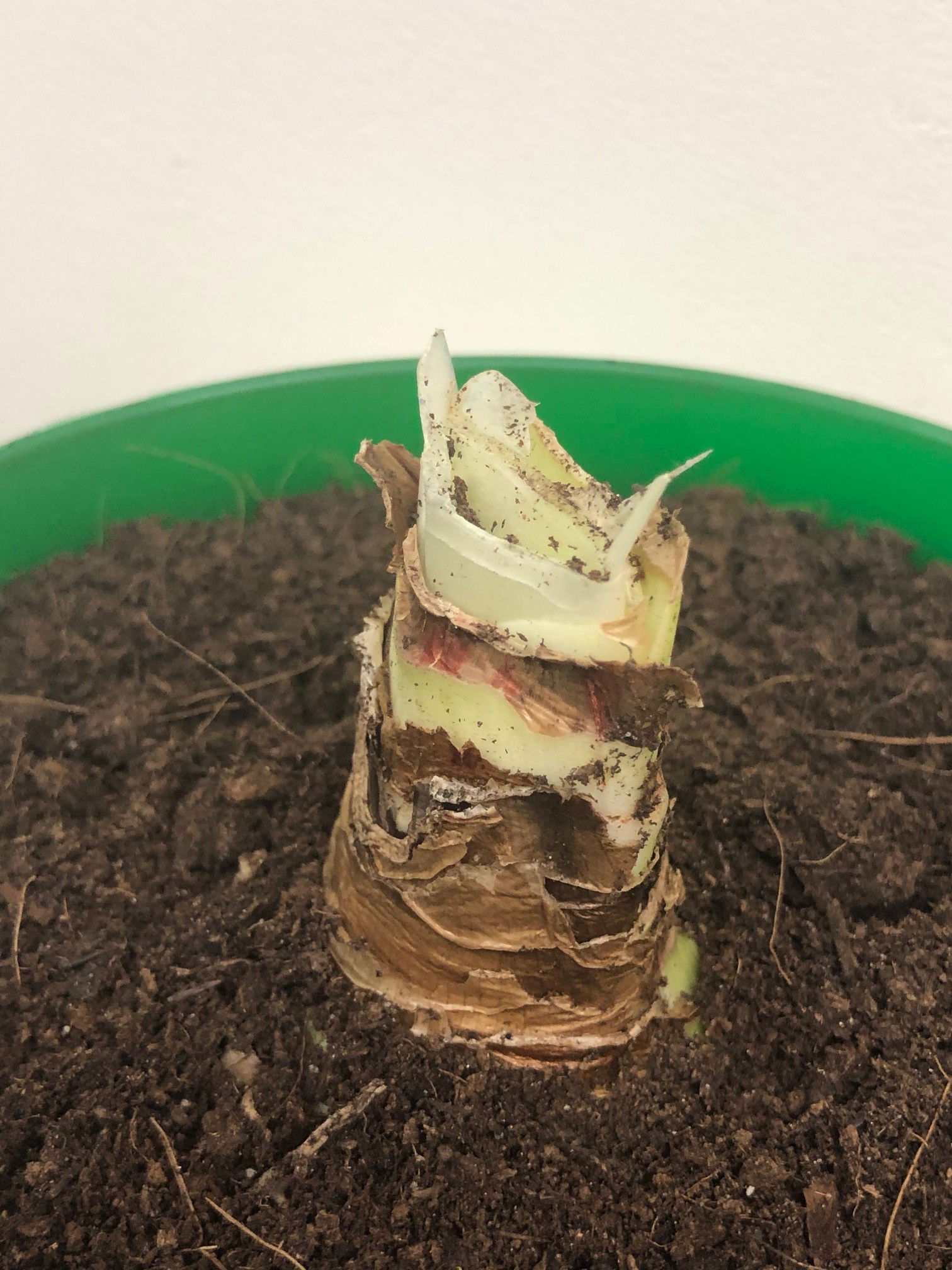 Try not to remove any more of the stem than this, as it may damage the top of the bulb.
Try not to remove any more of the stem than this, as it may damage the top of the bulb.
Propagation
Via Seed or Bulbil Division.
During the spring or summer, take the bulb out of the soil and inspect its health below the soil line. Trim away any of the dead roots and search for small bulbous growths that'll develop near to the basal plate. If the bulb is at least 15% of the mother plant's size, it can be removed and potted in its own soil. Don't worry if there aren't any roots, this will soon develop once the plant starts to fend for itself. Place the bulb vertically into the soil ('Cacti & Succulent' labelled compost is best), ensuring the 'neck' is still above the soil line. For those who are a little confused with how far to submerge the bulb, and what a 'bulbil' looks like, have a look at the images below. The level of maturity will greatly depict when the bulb will next flower; smaller specimens (around 2cm in diameter) generally taking two or three years from propagation.
N.B. - Do not separate the bulbs whilst the plant is in flower, as this may lead to sudden flower loss or transplant shock.
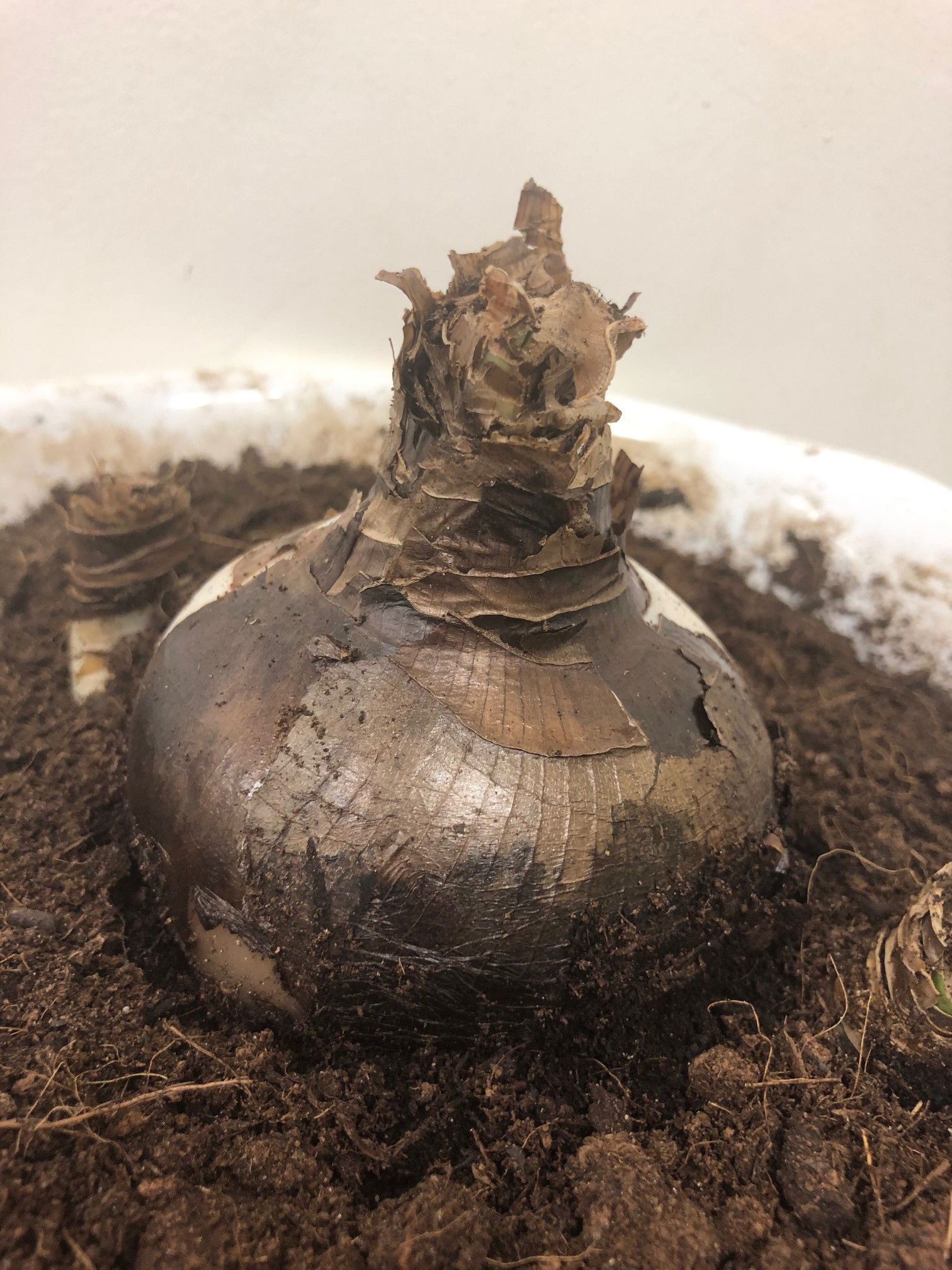 Submerge the bulb at least 30% beneath the soil line.
Submerge the bulb at least 30% beneath the soil line.
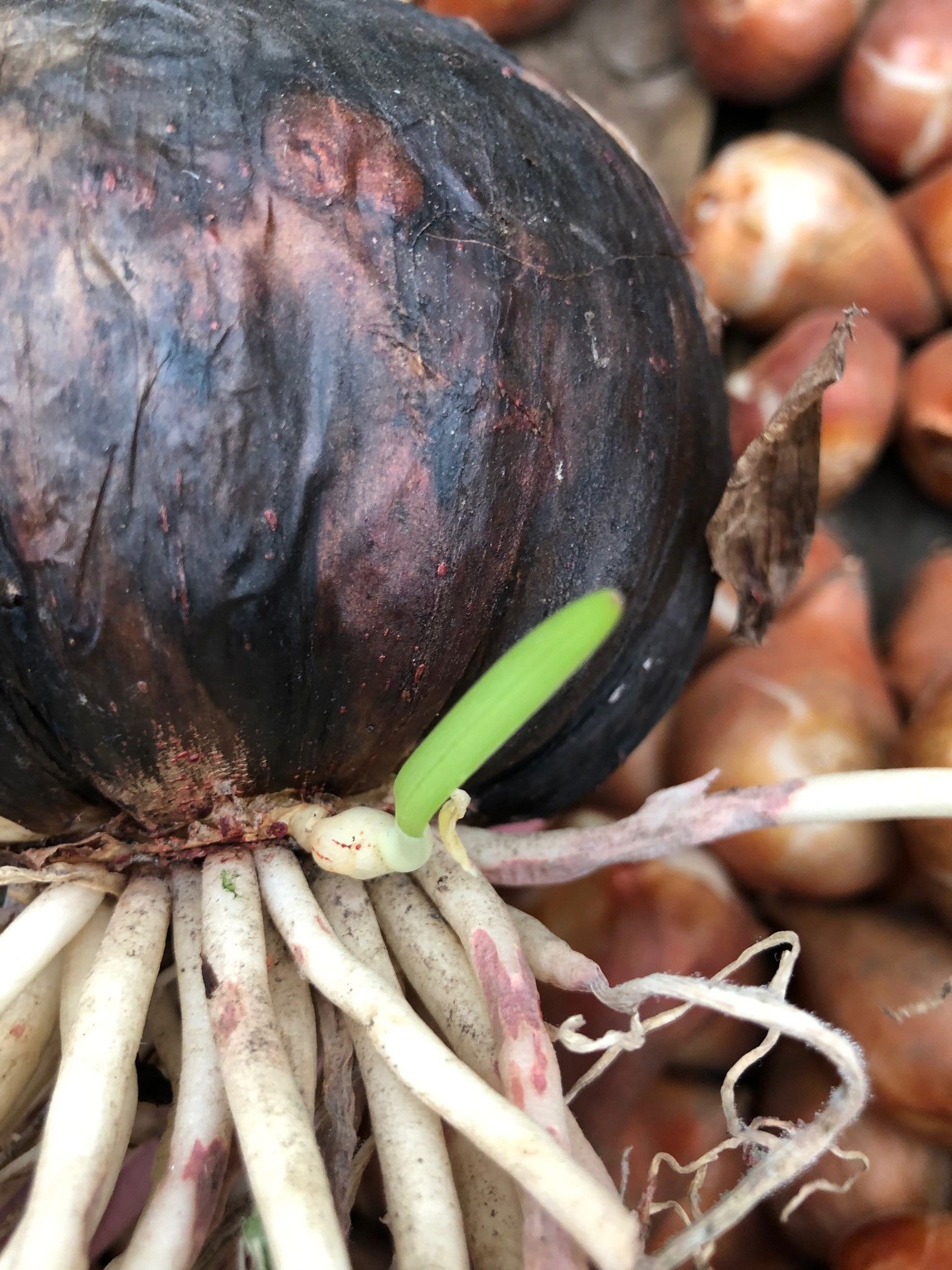 An immature 'bulbil' that can be separated once it's at least 15% of the mother bulb's size.
An immature 'bulbil' that can be separated once it's at least 15% of the mother bulb's size.
Flowers
Their flowers are relatively large, trumpet-shaped flowers that are arranged in threes or fours at the top of one or two shafts, usually around 30cm in height. The individual flower will last up to a week, with the overall show spanning three to four weeks. Most specimens will bloom within the region of March to late July, but can flower at any given time including the festive period.
If you'd like to get your specimen to bloom in time for the festive period, scroll up to the section labelled 'Dormancy Care & Annual Flowers' for more information.
Repotting
During the summer, repot every three to four years using 'Cactus & Succulent' compost with added perlite or grit. It's unadvised to plant an Amaryllis into a pot which lacks drainage holes, as the chance of bulb or root rot is high.
If it's your first time potting the bulb, it's essential to pot an Amaryllis with the top 30% above the soil line - scroll up to the images above for visual help. Place the bulb vertically into the compost, making sure that the pot has enough room to accommodate a few years of root growth. Although the rule of thumb is to repot a houseplant biannually, Amaryllis will thrive and bloom for many years if their root systems are restricted. Never perform a transplant whilst the plant is in bloom.
Book a 1-to-1 video call with THE HOUSEPLANT DOCTOR™ if you'd like a personal guide to repotting your houseplant. This will include recommending the right branded-compost and pot size, followed by a live video call whilst you transplant the specimen for step-by-step guidance and answer any further questions!
Pests & Diseases
Keep an eye out for spider mites (very rarely), thrips, aphids, mealybugs and snails/slugs if kept outdoors over the summer. Common diseases with Amaryllis are bulb or root rot, powdery mildew, leaf-spot disease and botrytis petal blight. Most diseases are caused by excess moisture in the soil or on the flowers or foliage; maintain dry leaves and always avoid water-logging for best results. For more info on how to address any of these issues, hit this link - Identifying Common Houseplant Pests & Diseases.
Toxicity
This plant is classified as poisonous. If parts of the plants are eaten, vomiting, nausea and a loss of appetite could occur. Consumption of large quantities must be dealt with quickly; acquire medical assistance for further information.
Retail Locations
Shortly before and after the Christmas period. Specimens are likely to be found in most garden centres and supermarkets across the northern hemisphere and may appear around Easter in Australia. Choose the healthiest example that sport no signs of stress in the likes of a softened bulb or a lack of roots.
Book a 1-to-1 Call with THE HOUSEPLANT DOCTOR™
If you need further advice with your houseplants, book an advice call with ukhouseplants' friendly and expert writer today! This can be done via a video or audio call on most apps, including Facebook, FaceTime & Skype. A ten-minute call costs £6.95 (US$8), or £15.95 for thirty minutes. You can ask multiple questions, including queries on plants, pests, terrariums, repotting advice and anything in between. Please consider supporting this service to keep ukhouseplants thriving!